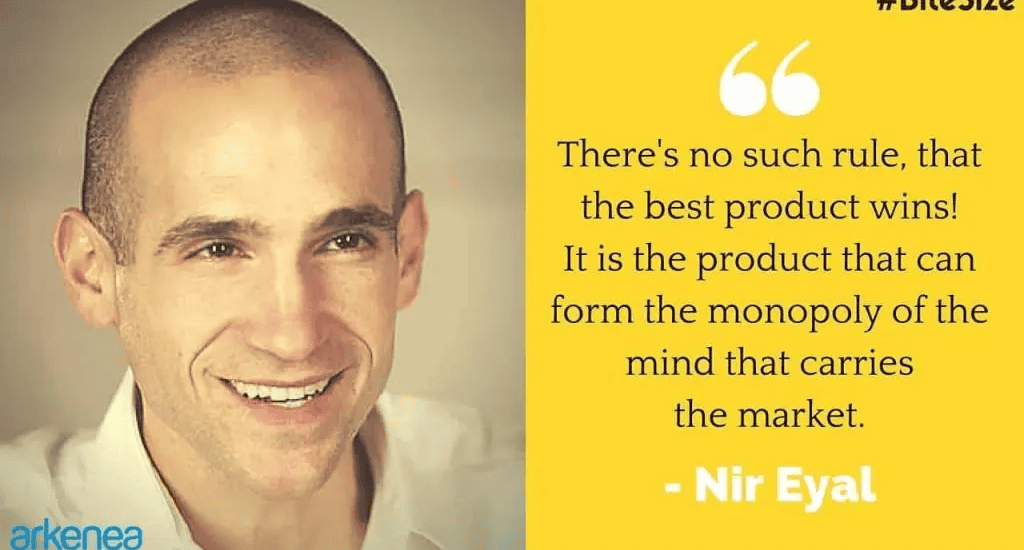How To Win Your Competitor’s Customers? Nir Eyal Shares 3 Strategies
- May 19, 2016
- Posted by: Nidhi Shah
- Category: Healthcare App Development

In the latest episode of #BiteSize, Nir Eyal gives out three actionable strategies to win your competitor’s customers.
Nir Eyal
Nir Eyal writes, consults, and teaches about the intersection of psychology, technology, and business. The M.I.T. Technology Review dubbed Nir, “The Prophet of Habit-Forming Technology.” Nir founded two tech companies since 2003 and has taught at the Stanford Graduate School of Business and the Hasso Plattner Institute of Design at Stanford. He is the author of the bestselling book, Hooked: How to Build Habit-Forming Products.
In addition to blogging at NirAndFar.com, Nir is a contributing writer for TechCrunch, Inc. and Psychology Today.
Some of his past investments include: Eventbrite, Product Hunt, Pantry, Refresh.io (acquired by LinkedIn), Happy Bits, Presence Learning, 7 Cups of Tea, Pana, and Symphony Commerce.
Transcript
This is a terrific question and it explains why habits are so valuable. One of the reasons that habits are so valuable is that they create barriers to entry. This means if a company has established a habit it’s very difficult for a competitor to come in and take that customer away.
So, if you are lucky enough to have built a consumer habit, you can kind of relax because it is very difficult for someone to take your customer away.
Look at Google. Google owns about 80% market share and it’s not because it is a better product. It’s just not a better product. In fact, a third-party did head-to-head independent comparisons for a Google search versus a Bing search.
When they took the branding out so that people didn’t know whose search results were whose, nobody could tell it apart. It was a 50-50 split because there is no rule written anywhere that says the best product wins.
I have never seen that rule anywhere.
In fact, it’s not necessarily that the best product wins, it’s the product that can form the monopoly of the mind that can carry the market.
So, what do you do?
If you have the habit, terrific! You can be like Google and cash in. But if you are not lucky enough to form that habit, may be your competitor has that habit, what do you do, how do you break that consumer habit and try and capture for yourself?
Well, there are only three ways that I know of to capture a competitor’s habit.
1. Frequency
The first is to get the user pass through the ‘Hook’. Remember the ‘Hook’ is the 4-step process- the trigger, the action, the reward, and the investment, which I described in my book. If you can get a user to pass through the ‘Hook’ with greater frequency meaning throughout the day if you can be the app/solution that they pass through the ‘Hook’ more frequently with your product versus your competitor’s product- that’s the first way to break their habit with a competitor’s product.
2. Velocity
The second way is to increase the velocity, meaning the speed with which they go through the four steps of the ‘Hook’.
So, if you can build a product that’s easier to use, if you give the user’s what they came for to scratch their itch and take them through the trigger, action, reward, investment faster than your competition, that’s the second way to break a competitor’s habit.
3. Making the reward more rewarding
If you can make a product that’s not just a little bit better, but has to be ten times better. Then your competitor’s solution in terms of scratching the user’s itch, solving their problem, goes from psychological and functional stand point, then you stand a chance. It can’t be just a little bit better, it has to be 10x better.
A good example of that is- one reason that Facebook is so scared of Snapchat. Zuckerberg offered Snapchat $3 billion and they turned down the offer. The reason Zuckerberg is so scared of Snapchat and the reason why Facebook bought Whatsapp and Instagram was because they threatened to own their habit, because the reward was more rewarding.
Let me illustrate, if were to receive a message Facebook and at the same time you received one from Snapchat, which would you open first?
Of course, you would open the Snapchat because Snapchat has this property of the messages exploding. So, you are much more likely to see a post that’s flirty or funny or has a little bit less discretion to it.
So, the reward- the reason we use the product in the first place- mainly to connect with people and leave out our boredom is better than the existing solution, a lot better. That’s why it is a threat to that existing habit.
So, velocity, frequency and the reward has to be more rewarding.
